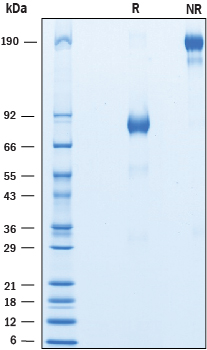Recombinant Mouse CLF-1/CLC Complex Protein, CF
Recombinant Mouse CLF-1/CLC Complex Protein, CF Summary
Product Specifications
| Mouse CLF-1 (Gly40-Gly425) Accession # Q9JM58 | SGGGGSGGGGSGGGGS | Mouse CLC (Leu28-Phe225) Accession # Q9QZM3 | HHHHHH |
| N-terminus | C-terminus | ||
Analysis
Product Datasheets
Carrier Free
CF stands for Carrier Free (CF). We typically add Bovine Serum Albumin (BSA) as a carrier protein to our recombinant proteins. Adding a carrier protein enhances protein stability, increases shelf-life, and allows the recombinant protein to be stored at a more dilute concentration. The carrier free version does not contain BSA.
In general, we advise purchasing the recombinant protein with BSA for use in cell or tissue culture, or as an ELISA standard. In contrast, the carrier free protein is recommended for applications, in which the presence of BSA could interfere.
10088-CL
| Formulation | Lyophilized from a 0.2 μm filtered solution in PBS. |
| Reconstitution | Reconstitute at 250 μg/mL in PBS. |
| Shipping | The product is shipped at ambient temperature. Upon receipt, store it immediately at the temperature recommended below. |
| Stability & Storage: | Use a manual defrost freezer and avoid repeated freeze-thaw cycles.
|
Scientific Data
 View Larger
View Larger
2 μg/lane of Recombinant Mouse CLF‑1/CLC Complex (Catalog # 10088-CL) was resolved with SDS-PAGE under reducing (R) and non-reducing (NR) conditions and visualized by Coomassie® Blue staining, showing bands at 77-87 kDa and 160-180 kDa, respectively.
Reconstitution Calculator
Background: CLF-1/CLC Complex
Cardiotrophin-like cytokine (CLC), also known as novel neurotrophin-1 (NNT-1) and B cell stimulating factor (BSF-3), is a member of the IL-6 family of cytokines (1, 2). CLC associates with the secreted soluble cytokine-like factor 1 (CLF-1), a member of the cytokine type I receptor family, to form the heteromeric composite cytokine CLF-1/CLC (3, 5). CLC can also form an alternate composite cytokine with soluble ciliary neurotrophic factor receptor alpha (CNTF R alpha ) (4). Co-expression of CLC with either CLF-1 or CNTF R alpha is required for the formation of the composite cytokines and for CLC secretion (3-5). CLF-1/CLC binds to the membrane-associated CNTF R alpha to initiate the heterodimerization between gp130 and leukemia inhibitory factor receptor (LIFR) and stimulate the PI 3-kinase and the MAP kinase activity. The CLF-1/CLC complex displays activities only on those cells expressing the functional tripartite receptor complex (5). Mouse CLF-1 is a 425 amino acid (aa) protein that contains a 33 aa signal sequence and a 392 aa chain. Mouse CLC is a 225 amino acid (aa) protein that contains a 27 aa signal sequence and a 198 aa chain. Human and mouse CLF-1 share 94% amino acid sequence identity. Human and mouse CLC shares 96% amino acid sequence identity. CLF-1/CLC supports the survival of embryonic motor and sympathetic neurons and has been shown to induce astrocytes differentiation of fetal neuroepithelial cells (4-6). Both CLF-1 and CLC are expressed in the embryo, suggesting that the composite cytokine may have an important role in nervous system development (5, 7). CLC has also been shown to regulate immune functions by stimulating B cell proliferation and Ig production (8).
- Senaldi, G. et al. (1999) Proc.Natl. Acad. Sci. USA 96:11458.
- Shi, Y. et al. (1999) Biochem. Biophys. Res. Commun. 262:132.
- Elson, G.C.A. et al. (1998) J. Immunol. 161: 1371.
- Plun-Favreau, H. et al. (2001) EMBO J. 20:1692.
- Elson, G.C.A. et al. (2000) Nature Neurosci. 3:867.
- Uemura, A. et al. (2002) Cytokine 18:1.
- Lelievre, E. et al. (2001) J. Biol. Chem. 276:22476.
- Senaldi, G. et al. (2002) J. Immunol. 168:5690.
FAQs
No product specific FAQs exist for this product, however you may
View all Proteins and Enzyme FAQsReviews for Recombinant Mouse CLF-1/CLC Complex Protein, CF
There are currently no reviews for this product. Be the first to review Recombinant Mouse CLF-1/CLC Complex Protein, CF and earn rewards!
Have you used Recombinant Mouse CLF-1/CLC Complex Protein, CF?
Submit a review and receive an Amazon gift card.
$25/€18/£15/$25CAN/¥75 Yuan/¥1250 Yen for a review with an image
$10/€7/£6/$10 CAD/¥70 Yuan/¥1110 Yen for a review without an image
